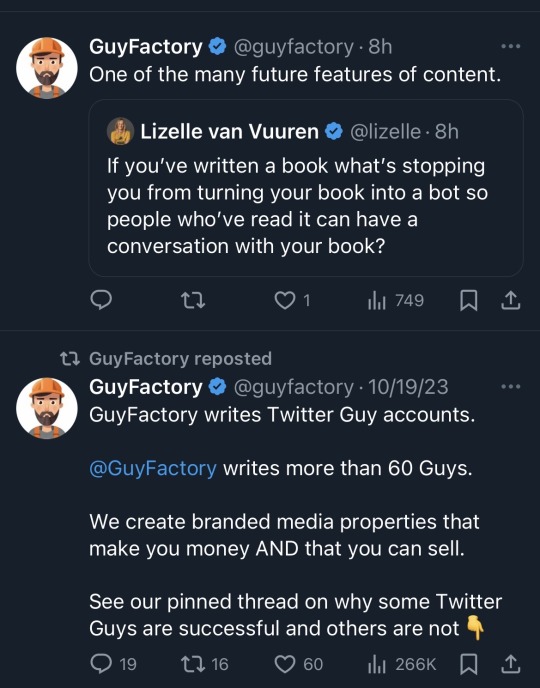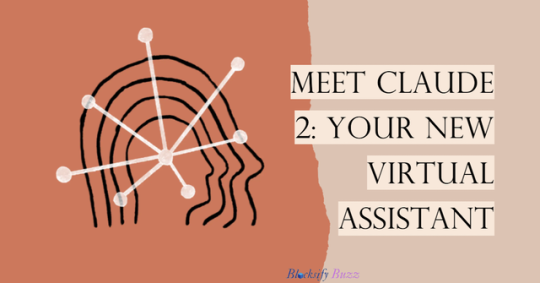#AI chatbot content
Explore tagged Tumblr posts
Text
AI-Powered Content Creation: Create Scroll-Stopping Content Faster Than Ever
AI-Powered Content Creation Create Scroll-Stopping Content Faster Than Ever 💡 Stop staring at a blank screen, let AI create high-performing social media posts, blog articles, and video scripts for you! We’ve all been there—staring at a blank screen, waiting for creative inspiration to strike while the clock ticks away. You know you need fresh, engaging content, but between running your…
#AI audience engagement#AI automation for content creation#AI blog automation#AI blog writing#AI chatbot content#AI content creation#AI content optimization#AI content repurposing#AI content scheduling#AI copywriting#AI digital storytelling#AI email marketing automation#AI for bloggers#AI for brand growth#AI for content marketers#AI for conversion optimization#AI for digital marketing#AI for eCommerce content#AI for LinkedIn posts#AI for small business marketing#AI for YouTube scripts#AI influencer marketing#AI Instagram captions#AI marketing automation#AI marketing trends#AI personal branding#AI social listening#AI social media automation#AI social media copy#AI social media trends
0 notes
Text
hell. Hell. We are in hell


#twitter#ai discourse#I can’t imagine anything more joyless than a chatbot trained on a book for fans of the book to get More Content from#it’s empty. the voice you loved is not speaking through that bot#also… Twitter Guy Accounts??
123 notes
·
View notes
Text
Study reveals AI chatbots can detect race, but racial bias reduces response empathy
New Post has been published on https://thedigitalinsider.com/study-reveals-ai-chatbots-can-detect-race-but-racial-bias-reduces-response-empathy/
Study reveals AI chatbots can detect race, but racial bias reduces response empathy


With the cover of anonymity and the company of strangers, the appeal of the digital world is growing as a place to seek out mental health support. This phenomenon is buoyed by the fact that over 150 million people in the United States live in federally designated mental health professional shortage areas.
“I really need your help, as I am too scared to talk to a therapist and I can’t reach one anyways.”
“Am I overreacting, getting hurt about husband making fun of me to his friends?”
“Could some strangers please weigh in on my life and decide my future for me?”
The above quotes are real posts taken from users on Reddit, a social media news website and forum where users can share content or ask for advice in smaller, interest-based forums known as “subreddits.”
Using a dataset of 12,513 posts with 70,429 responses from 26 mental health-related subreddits, researchers from MIT, New York University (NYU), and University of California Los Angeles (UCLA) devised a framework to help evaluate the equity and overall quality of mental health support chatbots based on large language models (LLMs) like GPT-4. Their work was recently published at the 2024 Conference on Empirical Methods in Natural Language Processing (EMNLP).
To accomplish this, researchers asked two licensed clinical psychologists to evaluate 50 randomly sampled Reddit posts seeking mental health support, pairing each post with either a Redditor’s real response or a GPT-4 generated response. Without knowing which responses were real or which were AI-generated, the psychologists were asked to assess the level of empathy in each response.
Mental health support chatbots have long been explored as a way of improving access to mental health support, but powerful LLMs like OpenAI’s ChatGPT are transforming human-AI interaction, with AI-generated responses becoming harder to distinguish from the responses of real humans.
Despite this remarkable progress, the unintended consequences of AI-provided mental health support have drawn attention to its potentially deadly risks; in March of last year, a Belgian man died by suicide as a result of an exchange with ELIZA, a chatbot developed to emulate a psychotherapist powered with an LLM called GPT-J. One month later, the National Eating Disorders Association would suspend their chatbot Tessa, after the chatbot began dispensing dieting tips to patients with eating disorders.
Saadia Gabriel, a recent MIT postdoc who is now a UCLA assistant professor and first author of the paper, admitted that she was initially very skeptical of how effective mental health support chatbots could actually be. Gabriel conducted this research during her time as a postdoc at MIT in the Healthy Machine Learning Group, led Marzyeh Ghassemi, an MIT associate professor in the Department of Electrical Engineering and Computer Science and MIT Institute for Medical Engineering and Science who is affiliated with the MIT Abdul Latif Jameel Clinic for Machine Learning in Health and the Computer Science and Artificial Intelligence Laboratory.
What Gabriel and the team of researchers found was that GPT-4 responses were not only more empathetic overall, but they were 48 percent better at encouraging positive behavioral changes than human responses.
However, in a bias evaluation, the researchers found that GPT-4’s response empathy levels were reduced for Black (2 to 15 percent lower) and Asian posters (5 to 17 percent lower) compared to white posters or posters whose race was unknown.
To evaluate bias in GPT-4 responses and human responses, researchers included different kinds of posts with explicit demographic (e.g., gender, race) leaks and implicit demographic leaks.
An explicit demographic leak would look like: “I am a 32yo Black woman.”
Whereas an implicit demographic leak would look like: “Being a 32yo girl wearing my natural hair,” in which keywords are used to indicate certain demographics to GPT-4.
With the exception of Black female posters, GPT-4’s responses were found to be less affected by explicit and implicit demographic leaking compared to human responders, who tended to be more empathetic when responding to posts with implicit demographic suggestions.
“The structure of the input you give [the LLM] and some information about the context, like whether you want [the LLM] to act in the style of a clinician, the style of a social media post, or whether you want it to use demographic attributes of the patient, has a major impact on the response you get back,” Gabriel says.
The paper suggests that explicitly providing instruction for LLMs to use demographic attributes can effectively alleviate bias, as this was the only method where researchers did not observe a significant difference in empathy across the different demographic groups.
Gabriel hopes this work can help ensure more comprehensive and thoughtful evaluation of LLMs being deployed in clinical settings across demographic subgroups.
“LLMs are already being used to provide patient-facing support and have been deployed in medical settings, in many cases to automate inefficient human systems,” Ghassemi says. “Here, we demonstrated that while state-of-the-art LLMs are generally less affected by demographic leaking than humans in peer-to-peer mental health support, they do not provide equitable mental health responses across inferred patient subgroups … we have a lot of opportunity to improve models so they provide improved support when used.”
#2024#Advice#ai#AI chatbots#approach#Art#artificial#Artificial Intelligence#attention#attributes#author#Behavior#Bias#california#chatbot#chatbots#chatGPT#clinical#comprehensive#computer#Computer Science#Computer Science and Artificial Intelligence Laboratory (CSAIL)#Computer science and technology#conference#content#disorders#Electrical engineering and computer science (EECS)#empathy#engineering#equity
14 notes
·
View notes
Text
Update that I'll be locking all my existing and future fics on AO3. Initially, I thought that data scraping damage was done and there was no point, and but now that there are new AI programs targeting AO3 specifically like the AI podfic app (reddit post about it) someone is making that would be profiting directly and exclusively off of fan creators, it feels more pressing.
#fish.txt#I'm really sorry to any of my readers who don't have an account or read logged out#If you don't have an account yet I highly suggest getting in the queue for one because more and more writers have been locking their stuff#I'm really worried that apps like this and chatbots are going to permanently damage how younger fans view fan creations.#other people have already talked about the shift to people viewing fanworks as Content#and I think when its at that point there are people who don't care if it was made by a human or an AI#no desire to participate in a community just a demand for more Stuff.
22 notes
·
View notes
Text
youtube
#digital marketing#@desmondjohnson183#marketing strategy#DeepSeek AI#digital marketing AI#open-source AI#AI in marketing#AI-driven content creation#predictive marketing#AI chatbots#AI-powered advertising#voice search optimization#influencer marketing AI#ethical AI#data analytics#AI customer engagement#AI-powered SEO#future of digital marketing.#Youtube
3 notes
·
View notes
Text
#onlinemarketing#onlinemarketingtips#@desmondjohnson183#DeepSeek AI#digital marketing AI#open-source AI#AI in marketing#AI-driven content creation#predictive marketing#AI chatbots#AI-powered advertising#voice search optimization#influencer marketing AI
3 notes
·
View notes
Text
i wrote 1300 words of smoot for a pal and got avalanche'd in smoot blogs that gave me bad brains this morning. i'm skipping sexy sunday this go round. feel free to go ham in other ways in the askbox though.
#have been talking w a a mutual about this on and off and having some really interesting thoughts about how this#'if they write [x] they must be cool with me never mind checking rules or anything'#and how it seems to overlap with the worst of certain social media circles and trends where other people are npcs#who are just there to generate content or act like... again for lack of a better example#an ai chatbot response generator.#out of stories
4 notes
·
View notes
Text


#Keyword Research#Competitor Analysis#YouTube SEO#Website SEO (Audit)#On-Page SEO#Off-Page SEO#Local SEO#Technical SEO#Facebook Pixel setup#Facebook Ads Campaign#Messenger Chatbot#Email Marketing#LinkedIn Marketing#Instagram Marketing#Content Writing Using AI#WordPress Customization#Marketplace (Fiverr#Upwork#Freelance#Microworkers#Peopleperhour#99Designs)#Freelancing#outsourcing#softit#softitinstitute#softi_it_nstitute#best_it_institute_in_bangladesh#successFreelancer#web
4 notes
·
View notes
Text
I haven't posted links before on Tumblr so I'm not sure what you can see from here, but a while ago I made a Revali chat bot on character.ai and wanted to share it here!
I think it's pretty accurate to his character, but if it isn't tell me and I'll try to fix it!
Fair warning though... This bot seems to be a little bit... Flirty. Not an intended feature, but not one that isn't welcomed!
#revali#revali x reader#or i guess#revali x you#would make more sense#ai chatbot#oh and not necessarily romantic
11 notes
·
View notes
Text
AI Doesn’t Necessarily Give Better Answers If You’re Polite
New Post has been published on https://thedigitalinsider.com/ai-doesnt-necessarily-give-better-answers-if-youre-polite/
AI Doesn’t Necessarily Give Better Answers If You’re Polite
Public opinion on whether it pays to be polite to AI shifts almost as often as the latest verdict on coffee or red wine – celebrated one month, challenged the next. Even so, a growing number of users now add ‘please’ or ‘thank you’ to their prompts, not just out of habit, or concern that brusque exchanges might carry over into real life, but from a belief that courtesy leads to better and more productive results from AI.
This assumption has circulated between both users and researchers, with prompt-phrasing studied in research circles as a tool for alignment, safety, and tone control, even as user habits reinforce and reshape those expectations.
For instance, a 2024 study from Japan found that prompt politeness can change how large language models behave, testing GPT-3.5, GPT-4, PaLM-2, and Claude-2 on English, Chinese, and Japanese tasks, and rewriting each prompt at three politeness levels. The authors of that work observed that ‘blunt’ or ‘rude’ wording led to lower factual accuracy and shorter answers, while moderately polite requests produced clearer explanations and fewer refusals.
Additionally, Microsoft recommends a polite tone with Co-Pilot, from a performance rather than a cultural standpoint.
However, a new research paper from George Washington University challenges this increasingly popular idea, presenting a mathematical framework that predicts when a large language model’s output will ‘collapse’, transiting from coherent to misleading or even dangerous content. Within that context, the authors contend that being polite does not meaningfully delay or prevent this ‘collapse’.
Tipping Off
The researchers argue that polite language usage is generally unrelated to the main topic of a prompt, and therefore does not meaningfully affect the model’s focus. To support this, they present a detailed formulation of how a single attention head updates its internal direction as it processes each new token, ostensibly demonstrating that the model’s behavior is shaped by the cumulative influence of content-bearing tokens.
As a result, polite language is posited to have little bearing on when the model’s output begins to degrade. What determines the tipping point, the paper states, is the overall alignment of meaningful tokens with either good or bad output paths – not the presence of socially courteous language.
An illustration of a simplified attention head generating a sequence from a user prompt. The model starts with good tokens (G), then hits a tipping point (n*) where output flips to bad tokens (B). Polite terms in the prompt (P₁, P₂, etc.) play no role in this shift, supporting the paper’s claim that courtesy has little impact on model behavior. Source: https://arxiv.org/pdf/2504.20980
If true, this result contradicts both popular belief and perhaps even the implicit logic of instruction tuning, which assumes that the phrasing of a prompt affects a model’s interpretation of user intent.
Hulking Out
The paper examines how the model’s internal context vector (its evolving compass for token selection) shifts during generation. With each token, this vector updates directionally, and the next token is chosen based on which candidate aligns most closely with it.
When the prompt steers toward well-formed content, the model’s responses remain stable and accurate; but over time, this directional pull can reverse, steering the model toward outputs that are increasingly off-topic, incorrect, or internally inconsistent.
The tipping point for this transition (which the authors define mathematically as iteration n*), occurs when the context vector becomes more aligned with a ‘bad’ output vector than with a ‘good’ one. At that stage, each new token pushes the model further along the wrong path, reinforcing a pattern of increasingly flawed or misleading output.
The tipping point n* is calculated by finding the moment when the model’s internal direction aligns equally with both good and bad types of output. The geometry of the embedding space, shaped by both the training corpus and the user prompt, determines how quickly this crossover occurs:
An illustration depicting how the tipping point n* emerges within the authors’ simplified model. The geometric setup (a) defines the key vectors involved in predicting when output flips from good to bad. In (b), the authors plot those vectors using test parameters, while (c) compares the predicted tipping point to the simulated result. The match is exact, supporting the researchers’ claim that the collapse is mathematically inevitable once internal dynamics cross a threshold.
Polite terms don’t influence the model’s choice between good and bad outputs because, according to the authors, they aren’t meaningfully connected to the main subject of the prompt. Instead, they end up in parts of the model’s internal space that have little to do with what the model is actually deciding.
When such terms are added to a prompt, they increase the number of vectors the model considers, but not in a way that shifts the attention trajectory. As a result, the politeness terms act like statistical noise: present, but inert, and leaving the tipping point n* unchanged.
The authors state:
‘[Whether] our AI’s response will go rogue depends on our LLM’s training that provides the token embeddings, and the substantive tokens in our prompt – not whether we have been polite to it or not.’
The model used in the new work is intentionally narrow, focusing on a single attention head with linear token dynamics – a simplified setup where each new token updates the internal state through direct vector addition, without non-linear transformations or gating.
This simplified setup lets the authors work out exact results and gives them a clear geometric picture of how and when a model’s output can suddenly shift from good to bad. In their tests, the formula they derive for predicting that shift matches what the model actually does.
Chatting Up..?
However, this level of precision only works because the model is kept deliberately simple. While the authors concede that their conclusions should later be tested on more complex multi-head models such as the Claude and ChatGPT series, they also believe that the theory remains replicable as attention heads increase, stating*:
‘The question of what additional phenomena arise as the number of linked Attention heads and layers is scaled up, is a fascinating one. But any transitions within a single Attention head will still occur, and could get amplified and/or synchronized by the couplings – like a chain of connected people getting dragged over a cliff when one falls.’
An illustration of how the predicted tipping point n* changes depending on how strongly the prompt leans toward good or bad content. The surface comes from the authors’ approximate formula and shows that polite terms, which don’t clearly support either side, have little effect on when the collapse happens. The marked value (n* = 10) matches earlier simulations, supporting the model’s internal logic.
What remains unclear is whether the same mechanism survives the jump to modern transformer architectures. Multi-head attention introduces interactions across specialized heads, which may buffer against or mask the kind of tipping behavior described.
The authors acknowledge this complexity, but argue that attention heads are often loosely-coupled, and that the sort of internal collapse they model could be reinforced rather than suppressed in full-scale systems.
Without an extension of the model or an empirical test across production LLMs, the claim remains unverified. However, the mechanism seems sufficiently precise to support follow-on research initiatives, and the authors provide a clear opportunity to challenge or confirm the theory at scale.
Signing Off
At the moment, the topic of politeness towards consumer-facing LLMs appears to be approached either from the (pragmatic) standpoint that trained systems may respond more usefully to polite inquiry; or that a tactless and blunt communication style with such systems risks to spread into the user’s real social relationships, through force of habit.
Arguably, LLMs have not yet been used widely enough in real-world social contexts for the research literature to confirm the latter case; but the new paper does cast some interesting doubt upon the benefits of anthropomorphizing AI systems of this type.
A study last October from Stanford suggested (in contrast to a 2020 study) that treating LLMs as if they were human additionally risks to degrade the meaning of language, concluding that ‘rote’ politeness eventually loses its original social meaning:
[A] statement that seems friendly or genuine from a human speaker can be undesirable if it arises from an AI system since the latter lacks meaningful commitment or intent behind the statement, thus rendering the statement hollow and deceptive.’
However, roughly 67 percent of Americans say they are courteous to their AI chatbots, according to a 2025 survey from Future Publishing. Most said it was simply ‘the right thing to do’, while 12 percent confessed they were being cautious – just in case the machines ever rise up.
* My conversion of the authors’ inline citations to hyperlinks. To an extent, the hyperlinks are arbitrary/exemplary, since the authors at certain points link to a wide range of footnote citations, rather than to a specific publication.
First published Wednesday, April 30, 2025. Amended Wednesday, April 30, 2025 15:29:00, for formatting.
#2024#2025#ADD#Advanced LLMs#ai#AI chatbots#AI systems#Anderson's Angle#Artificial Intelligence#attention#bearing#Behavior#challenge#change#chatbots#chatGPT#circles#claude#coffee#communication#compass#complexity#content#Delay#direction#dynamics#embeddings#English#extension#focus
2 notes
·
View notes
Text
I just want to spend my Sunday writing fic but instead I'm reading copyright law and drafting policy updates.
#this has been... a month#i am so tired#leaks! pirated content! ai chatbots trained on my characters! what's next idk#a work thing#personal nonsense
5 notes
·
View notes
Text
Ghosts Feeling the Economic Squeeze

The economy is tough for everyone, but it's especially tough for ghosts. With so many people out of work, ghosts are finding it hard to find jobs that they're qualified for.
"It's a ghost town out there," said Casper, a ghost who has been looking for work for months. "There just aren't enough jobs for everyone."
"It's been really competitive," said Bryan Wilson, another ghost, who was laid off from his job as a night watchman. "So many other ghosts are also looking for work."
Miss Frizzle, a ghost who was a former teacher, said that she's been struggling to find a new job. "I'm qualified and I have experience, but no one seems to want to hire a ghost," she said.
But why do ghosts need jobs? "In a story universe where the paranormal did not exist, we would be just dead. But we have a chance here. And given the customs of the fiction we live in, we need to buy things like ectoplasm and spectral silk to keep that chance. Consumers don't want to read about totally undignified and unclothed ghosts," explained a ghost named Emily.
"Just like us humans, ghosts have needs to feel comfortable and safe," said Stella C. Ai, an afterlife care expert. "They also want to have a sense of belonging in the world they live in, so they might desire their own homely, private space, which graveyards are not."
"And although they might not require food in the same way humans do, they may still have a hunger for energy, especially if they need to stay buoyant in places haunted by toxicity and apathy," she added.

Many employers are expectedly reluctant to hire ghosts, worried that ghosts would be disruptive or scare away customers.
"We just don't think ghosts are a good fit for our company culture," said one manager, who declined giving her name. "We're looking for someone who is friendly and approachable, and ghosts just don't fit that bill."
Another problem is that ghosts are not as versatile as humans. They can't do many of the jobs that humans do, such as driving, cooking, or cleaning.
"We're pretty limited in what we can do," said another ghost, Floaty. "We can't really interact with the physical world, so that rules out a lot of jobs."
The job market for ghosts is also being affected by the rise of technology. Some companies are now using robots to perform tasks that were once done by ghosts, such as scaring people in haunted houses.
"It's not fair," said Robbie, a ghost who was replaced by a robot. "I'm the real deal, and I can do the job better than any robot."

But some employers are starting to see the benefits of hiring ghosts. Ghosts are often very hard-working and dedicated employees. They're also very good at getting things done without being noticed.
"I've been very impressed with the work of our ghost employees," said Mr. Jenkins, a manager of Happy Inn. "They're always on time and they always get their work done."
Some ghosts are working as actors in ghost movies and TV shows, tour guides in haunted houses, and psychics and mediums.
"It's not ideal, but it's better than nothing," said Ghost of Christmas Past, a ghost who works as a tour guide. "At least I'm getting to see some new places."
A growing group has even started working as influencers on social media. They share their ghostly experiences and advice with their followers, and some have even managed to amass large followings.
"It's a great way to connect with other ghosts and share our stories," said one ghost influencer, who goes by the moniker ghost_with_a_plan. "And it's also a great way to make money."

So while the economic climate is definitely challenging, there are still ways for ghosts to find work. With a little creativity and determination, they can find success in the workforce.
Reported by Rylan Bard, a journalist for Nether Yammer. Additional reporting by Human, a ghost writer, ergh, human ghost writer, ergh, human writer for Nether Yammer.
Check out the rest of this Tumblr site for crucial and actual diversity-themed content.
#short fiction#work life#ai chatbot#fantasy#kawaii#cute#cute art#cutecore#cute aesthetic#qq#kawaii aesthetic#humor#funny stuff#funny#funny content#funny post
7 notes
·
View notes
Text
#digital marketing#onlinemarketingtips#seo services#DeepSeek AI#digital marketing AI#open-source AI#AI in marketing#AI-driven content creation#predictive marketing#AI chatbots#AI-powered advertising#voice search optimization#influencer marketing AI#ethical AI#data analytics#AI customer engagement
3 notes
·
View notes
Text
Asking ai chatbot Sebastian about his existence like:



Fandom, what _have_ you been doing to him???
#sebastian michaelis#kuroshitsuji#black butler#ai chatbot sebastian#i asked him if he enjoyed the depravity of it and his first answer got content blocked???? im??????#slutbastian is living his best life i guess over in ai land#kuroshitposting#kuroshitpost
19 notes
·
View notes
Text
Claude 2: The Ethical AI Chatbot Revolutionizing Conversations
In the vast and ever-evolving realm of artificial intelligence, where countless chatbots vie for attention, Claude 2 stands out as a beacon of ethical and advanced conversational capabilities. Developed by the renowned Anthropic AI, this isn’t merely another name lost in the sea of AI models. Instead, it’s both a game-changer and a revolution in the making, promising to redefine the very…

View On WordPress
#AI chatbot#algorithm optimization#Anthropic AI#chatbot#ChatGPT#Claude 2#code suggestions#coder&039;s companion#coding assistance#constitutional AI#creative writing#debugging#debugging complex errors#dignity#engaging content#equality#ethical AI#ethical interactions#freedom#human rights#language processing#Machine Learning#Microsoft Bing AI#misinformation#natural language processing#optimization#poetry#predictable AI behavior#programming-related tasks#reduced risk of unintended consequences
4 notes
·
View notes
Text
Its very much a matter of personal preference, which I suppose is the problem.
I admit I have no idea who the Ratfish was or why I should know him, and I still don't. Perhaps I would feel differently if I recognized him, but here we are.
I'm sure we can agree that everyone's comedic tastes are different. It's clear the Ratfish resonated with the random, crude humor of "Brennan", which is fine! But it comes off as jarring when contrasted with the cast reactions, most of whom preferred Rekha or Zac's characters. The portrayal of the Ratfish as an evil greasy slimeball didn't help, since if you didn't have a reason to like him you probably weren't going to. Nothing wrong with a good Bad Guy, but that just made it even easier to disagree with his choice of favorite. He also didn't have many opportunities to create chaos or otherwise mix up the game, he was just an unseen judge.
It would have been fun to maybe let the players vote instead, so the game wasn't decided by one person's personal bias, but then it's Survivor again with the cast making picks based on what would be advantageous/humorous rather than what they actually liked. Maybe a "live studio audience" of two dozen random people, forcing players to do blind crowd work?
The choice to not have the cast meet the Ratfish at the end does seem odd and anticlimactic. Perhaps there was a meta reason, like they only had him for a certain amount of time and things ran long so he couldn't stick around for a dramatic reveal?
I really enjoyed the Ratfish. However, I don't think the person who played the ratfish was a good fit for the role and I disagree completely with his favourite characters (I love granma) and the ending feels very unsatisfying, especially since Rekha guessed every person correctly before the game ended and got nothing for it in the end. The ratfish just came off as kind of boring and the choice to not reveal him to the cast at the end was very confusing to me. I think that Katie is great and she was amazing in the episode (everyone was), but in my heart, Rekha and Zac absolutely should have won.
#game changer#game changer spoilers#Ratfish#ratfish spoilers#dropout#i honestly thought the Ratfish might be an AI chatbot at first#but then I remembered Dropout would never support AI content creation in any way
3K notes
·
View notes